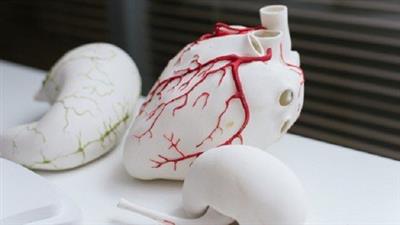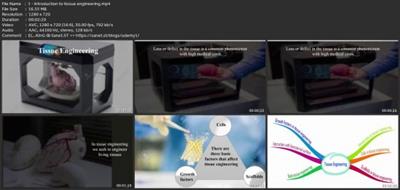M
0

Last updated 8/2020
MP4 | Video: h264, 1280x720 | Audio: AAC, 44.1 KHz
Language: English | Size: 432.18 MB | Duration: 1h 18m
Tissue Regeneration
MP4 | Video: h264, 1280x720 | Audio: AAC, 44.1 KHz
Language: English | Size: 432.18 MB | Duration: 1h 18m
Tissue Regeneration
What you'll learn
Introduction to tissue engineering
Cells in tissue engineering
Scaffolds in tissue engineering
Growth Factors in tissue engineering
Interaction with biomaterial surface
Body tissue engineering
Requirements
System requirements: PC, laptop or mobile device (with Udemy app) and broadband connectivity.
Course requirements: There are no pre-requisite or other course requirements.
Description
Loss or defect in the tissue is a common phenomenon with high medical costs that millions of people suffer annually. Some body tissues effectively undergo a self-healing process and initiate processes during tissue damage that lead to rapid and usually complete repair of damaged tissue. In some cases where the tissue is extensively damaged, for example in grade 3 burns, the body's self-healing methods are not sufficient and searching for methods to control natural processes is essential.In tissue engineering we seek to engineer living tissues and the desired tissue must be well known to be engineered on the basis of its various properties. Tissue engineering is to take care of nature and imitate the conditions inside the body. The human body is made up of cells and cells make up tissues and they make organs. Understanding the context in which cells grow is called the extracellular matrix as well as the molecules present in the environment are essential for the design of living tissues.Tissue engineering is nowadays considered as a possible alternative to tissue or organ transplantation. With this technology, organ failure can be treated through biologically engineered alternative implantation. In this way, the cells are removed from a patient and their numbers are increased and placed on a scaffold. Scaffolds can be either natural or synthetic or a combination of both.There are three basic factors that affect tissue engineering: cells, scaffolds, growth factorsIf only the cell is used, the cells must be able to secrete extracellular matrix material. If we use only biomaterials, migration of host tissue cells to the damaged area is essential for tissue regeneration.This course provides an overview of:· Introduction to tissue engineering· Cells in tissue engineering· Scaffolds in tissue engineering· Growth Factors in tissue engineering· Interaction with biomaterial surface· Body tissue engineeringThis course can be useful for students of tissue engineering, polymer and medical engineering and interested in this field.
Overview
Section 1: Introduction to tissue engineering
Lecture 1 Introduction to tissue engineering
Section 2: Cells in tissue engineering
Lecture 2 Cell structure
Lecture 3 Types of cells
Lecture 4 Stem Cells
Lecture 5 Cell culture
Lecture 6 Cell growth pattern
Lecture 7 Extracellular matrix
Lecture 8 Cell adhesion
Section 3: Scaffolds in tissue engineering
Lecture 9 Scaffolds in tissue engineering
Lecture 10 Common methods of scaffold construction
Lecture 11 Polymers in tissue engineering
Lecture 12 Natural polymers
Lecture 13 Synthetic polymers
Lecture 14 The effect of surface stiffness on cells
Lecture 15 Modification of biomaterial level
Section 4: Growth Factors
Lecture 16 Growth Factors
Lecture 17 Influence of Surface Mechanical Properties
Section 5: Interaction with biomaterial surface
Lecture 18 Cell-Biomaterial Interaction
Lecture 19 Protein-biomaterial interaction
Lecture 20 Protein adsorption
Lecture 21 Protein Properties and Biomaterial Surface Properties
Lecture 22 Tissue-Biomaterial Reaction
Section 6: Body tissue engineering
Lecture 23 Bone structure
Lecture 24 Bone Tissue Engineering
Lecture 25 Cartilage structure
Lecture 26 Cartilage tissue engineering
Lecture 27 Skin structure
Lecture 28 Skin Tissue Engineering
Lecture 29 Nerve structure
Lecture 30 Nerve tissue engineering
Lecture 31 The structure of blood vessels
Lecture 32 Tissue engineering of blood vessels
Lecture 33 Liver structure
Lecture 34 Liver Tissue Engineering
Lecture 35 Kidney structure
Lecture 36 Kidney tissue engineering
Section 7: lesson's text
Lecture 37 lesson's text
tissue engineering, polymer and medical engineering and interested in this field.,polymer engineering,medical engineering,Anyone interested in this field

Download link
rapidgator.net:
You must reply in thread to view hidden text.
uploadgig.com:
You must reply in thread to view hidden text.
nitroflare.com:
You must reply in thread to view hidden text.
1dl.net:
You must reply in thread to view hidden text.

